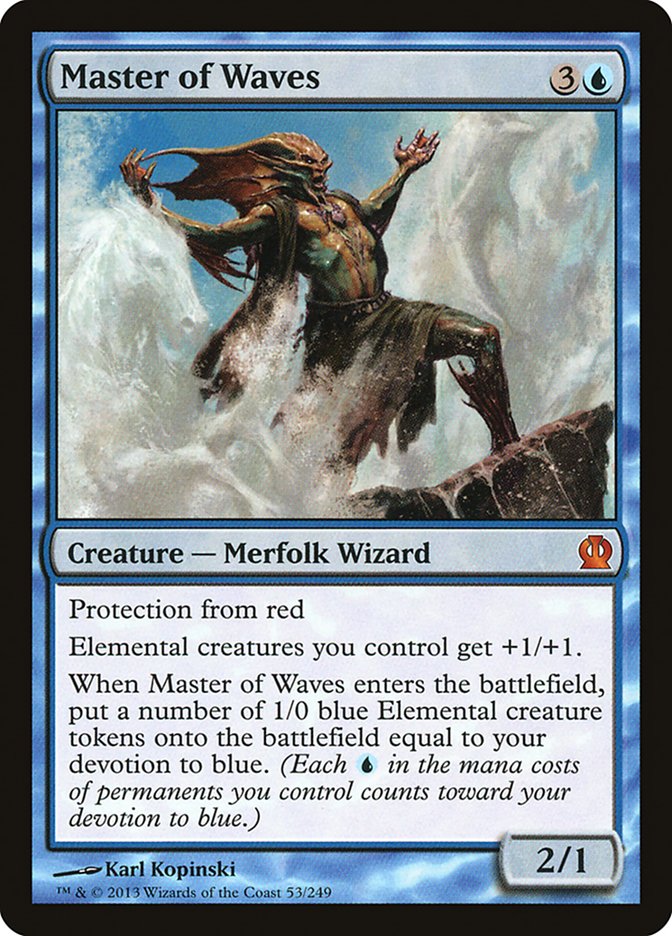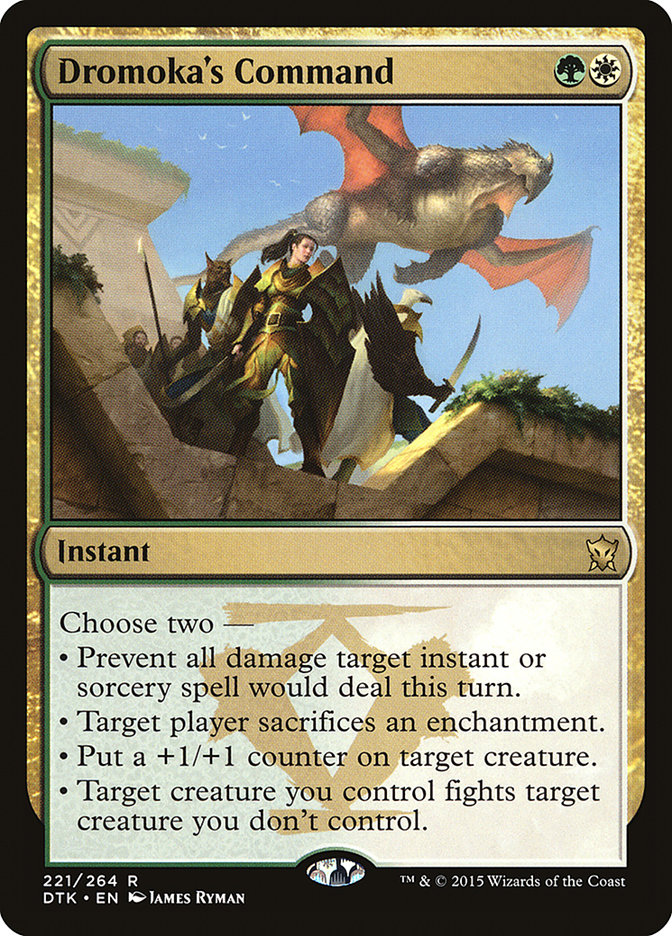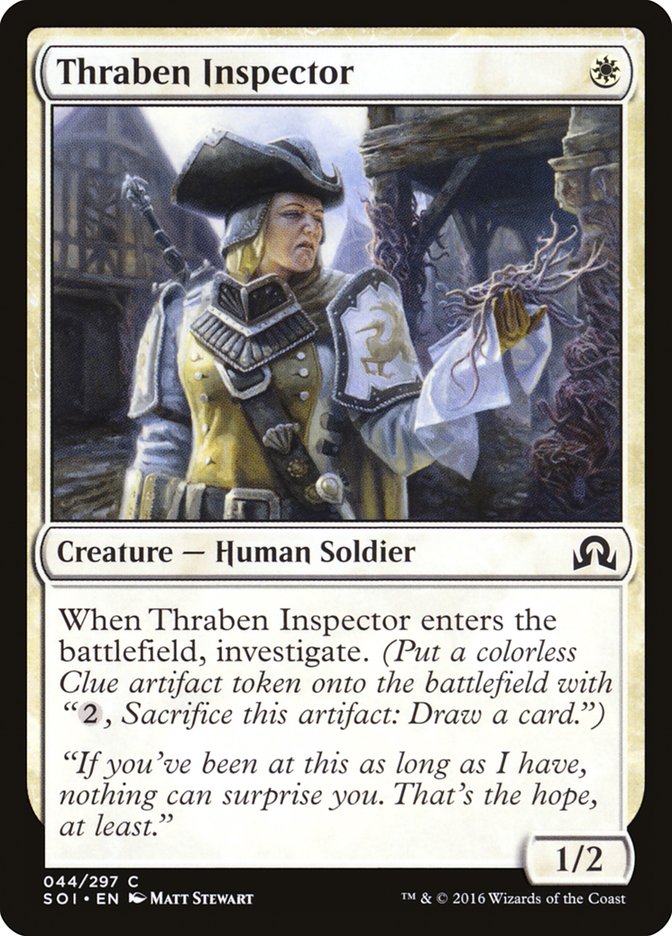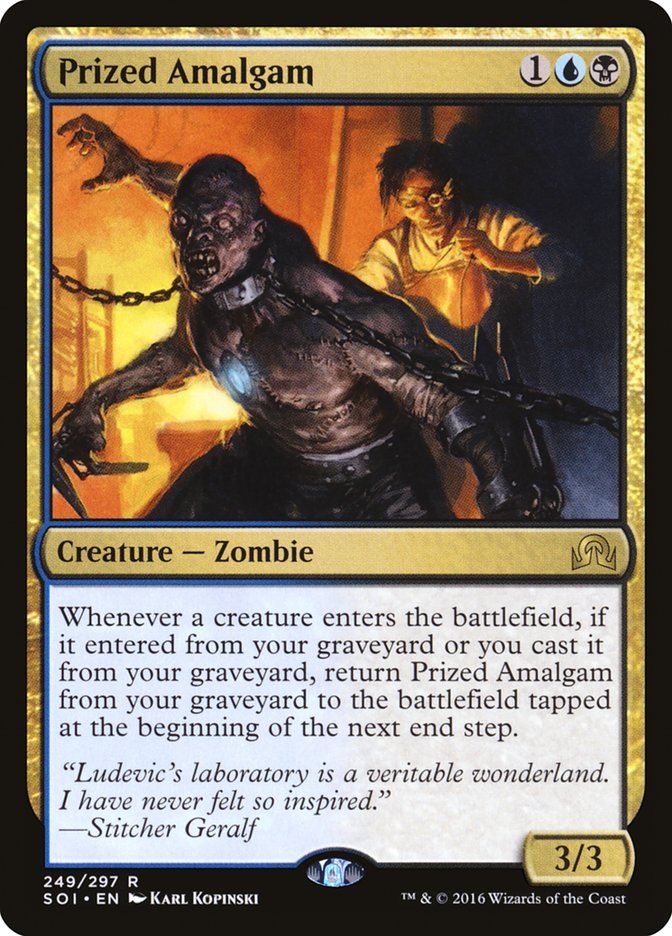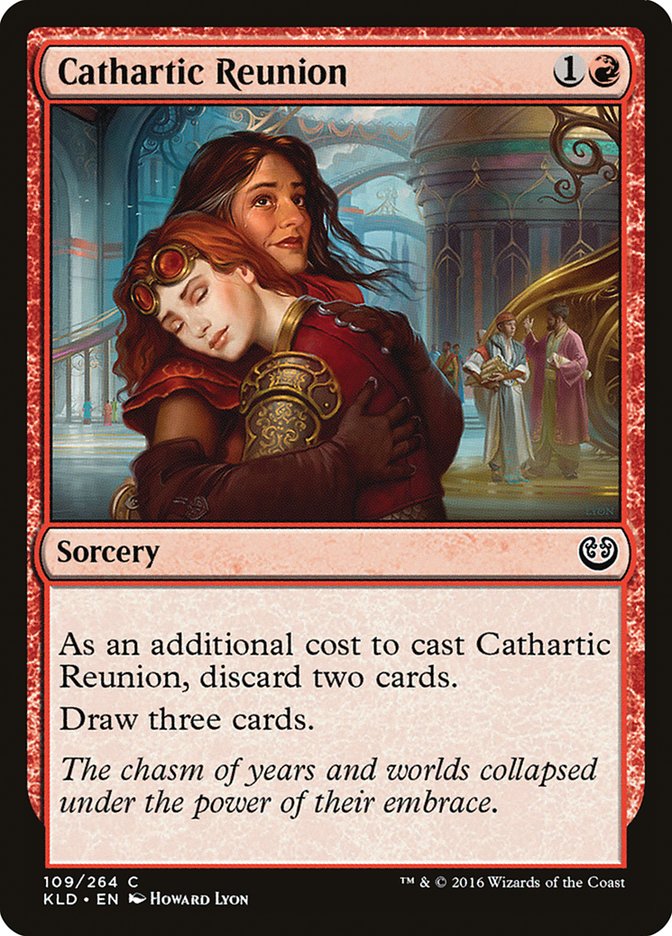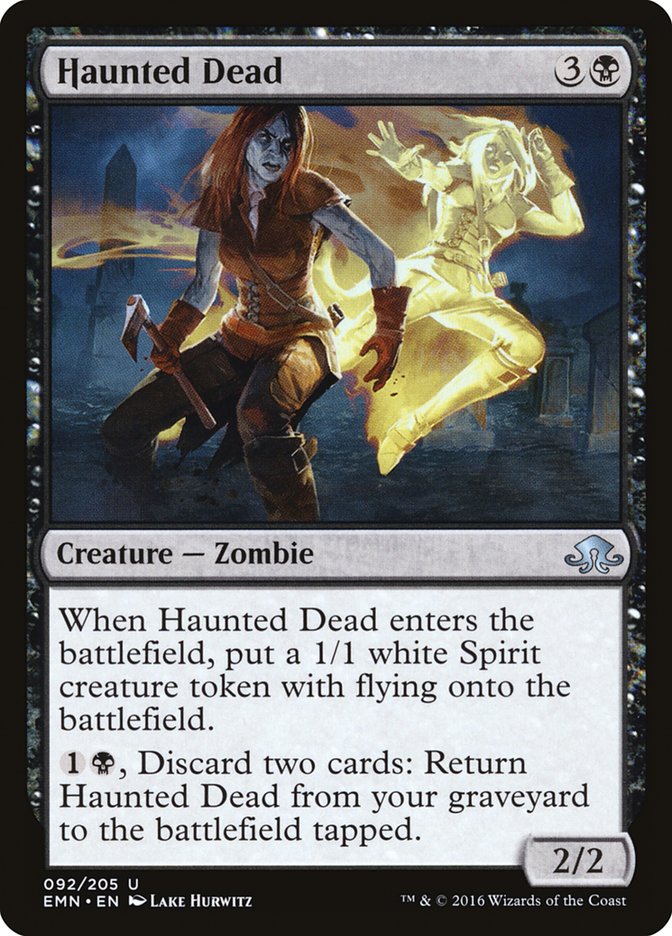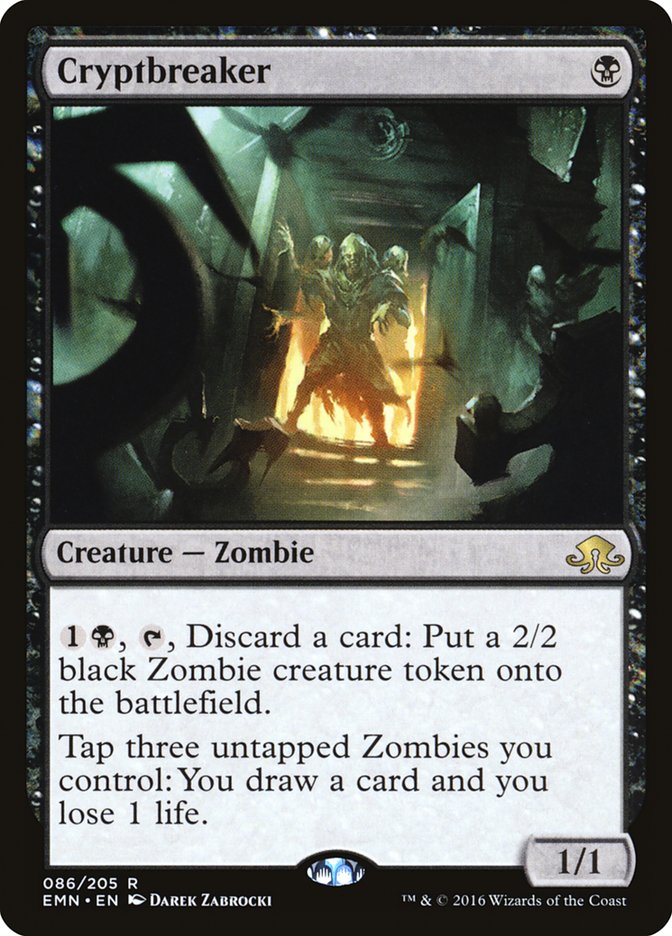One popular tool that successful Magic players tend to implement is breaking down the cards that the format rotates around rather than decks. A powerful card will see play across multiple archetypes and bleed into several strategies. This makes it easier to realize what exactly you’re trying to fight instead of metagaming against a variety of decks, which can overwhelm your sideboarding sensibilities and cause you to fret over matchups that you shouldn’t be instead of the specific pieces.
That sounded really good. I think I entered like…a fugue state and wrote it or something. Well, let’s run with it.
Traditionally Standard operates on a very linear axis. If you take a moment and understand how many powerful cards there are in a given format, the number shrinks to a handful very quickly. Last season we had Collected Company; Sylvan Advocate; Emrakul, the Promised End; Reflector Mage; Dromoka’s Command; and Thalia’s Lieutenant. I’m probably missing a few, but for the most part that list is fairly accurate. Before that there was Sphinx’s Revelation, Thoughtseize, Pack Rat, Underworld Connections, and Master of Waves.
When you’re able to come up with a comprehensive assessment of what the “best” cards are in Standard, you start to see where they intersect. That little grouping we just talked about above? Most of those cards were in Bant Company or its cousin, Bant Humans. From that point it was difficult to justify not playing either a deck that contained all of those creatures and spells, or at the very least one that had an extremely good matchup against it. Decks would come and go that could challenge these cards, but in the end Bant would adjust and remain on top of the metagame.
Today I’d like to talk about all of the best cards to emerge from Standard over the last few weeks. This will do a few different things for us:
1. Help us identify what we need to beat and how to do it.
2. See which cards intersect and give ourselves a de facto “best deck” to analyze.
In both situations, it’s more about being honest than biased. While I have certain cards that I love playing with, almost all of them will not make this list. The first one is obvious.
As someone who uses a hysterical amount of hyperbole, there is none when I say Smuggler’s Copter is the only card to come along in five years that might actually get banned in Standard. When dealing with it, there are several key factors to take into account.
1. Unlike other oppressive artifacts that have seen play over the years, such as Skullclamp, Umezawa’s Jitte, or Sensei’s Divining Top, Smuggler’s Copter mixes respectable pressure with card advantage.
2. It has more answers to it than the other artifacts because creature-kill spells are turned out.
3. Without an immediate answer, it has a very high ratio of games that allow it to roll downhill before an opponent can stabilize.
There were two Standard Grand Prix events this past weekend, in Providence as well as Kuala Lumpur. Both events saw a combined 425 copies out of a possible 512 in their Top 64s, clocking in at a wild 83% of Top 64 conversion. The last time something of this magnitude happened? Jace, the Mind Sculptor at 88% in Grand Prix Singapore.
For reference, Stoneforge Mystic was 70% at that same tournament. (Thanks to Allison Coleman for running these numbers!)
Oh, and Copter also put 23 out of 32 in the latest Top 8 of the Milwaukee Standard Classic, won by Team Nexus member Brad Carpenter.
Beating Smuggler’s Copter is both easy and incredibly challenging. Most spells like Grasp of Darkness, Harnessed Lightning, Blessed Alliance, Immolating Glare, or Stasis Snare are able to get underneath it and take it out. The crux is several of those spells allow the Copter to achieve an activation, which filters its draws and sculpt a better hand.
In a format dedicated solely to beating Smuggler’s Copter, most of this isn’t terribly difficult, but it would seem the format is more interested in playing with Copter and beating it, meaning most decks are prepared to fight wars where it is activated multiple times as well as protect their own.
This is the starting point to our axis, since it would be foolish to believe that it isn’t the most important card in Standard.
Notable Inclusions:
R/W Vehicles
W/U Flash
R/B Zombies
Mardu Vehicles
B/G Delirium
Bant Aggro
Without a doubt Thraben Inspector is the best one-drop in Standard. A simple 1/2 for a single mana that brings card draw along with it is powerful, but in a world where Inventor’s Apprentice and Toolcraft Exemplar exist, we’re talking about an activator as well.
There were 23 Smuggler’s Copters in the Top 8 of Milwaukee, and there were twenty copies of Thraben Inspector along with it. This is a natural pairing, since the Inspector will always give you some measure of value along with a body to crew your Copter that isn’t even remotely a large investment.
Because it plays so well with a half-dozen or so creatures and vehicles in Standard, Thraben Inspector goes from being a role-player and curve consideration for Standard decks of the past like Boss Humans or Bant to a full-fledged engine (no pun intended) for what many of the decks in the format are trying to do. There isn’t a great way to fight it that doesn’t feel bad: almost every viable removal spell in the format is more expensive than it, so you’re essentially trading down on mana, and the Clue it produces allows the Inspector to “replace” itself. You also have to consider that one of the best decks in Standard, Mardu Vehicles, is completely fine with you killing it, since it provided fuel for Scrapheap Scrounger.
Of course, it isn’t on par with one-drops of considerable power such as Disciple of the Vault or Deathrite Shaman, but Thraben Inspector is very quietly one of the best cards in Standard.
Notable Inclusions:
W/U Flash
R/W Vehicles
Mardu Vehicles
In the first week of Kaladesh Standard we heard reports that planeswalkers were in a great deal of trouble due to the aggressive nature of the format, along with Smuggler’s Copter being able to fly over the 2/2 Knight Ally token Gideon produces. Sometimes that Copter could be a 4/4 if it was crewed by a Veteran Motorist or if Depala, Pilot Exemplar was on the battlefield.
I guess people forgot what happens when Gideon is allowed to cruise the skies along with the marquee Vehicle. Milwaukee saw twenty of the four-drop planeswalker in its Top 8.
The first Gideon is able to provide a body to crew, but in many cases it’s correct to simply emblem him. When your Thraben Inspector is a 2/3, it can attack through theirs. Your 4/4 Smuggler’s Copter can battle through theirs. Bigger Archangel Avacyns. Spell Quellers that can survive Radiant Flames. The list goes on.
An emblem is only the beginning. This Standard is also heavily contingent on removal that has no effect on Gideon unless you’re able to put him under a Stasis Snare or set up a wicked turn with Blessed Alliance. This allows the decks utilizing him to apply immense pressure very quickly and begin attacking for around half your life total by turn 5. The decks now set up with Gideon are very good at protecting it and attacking, slamming various creatures with flash or instant-speed removal like Unlicensed Disintegration.
With cards like Ruinous Path getting worse and worse, more marginalized as it were, as Standard gets more aggressive and flash-oriented, the stock in planeswalkers goes up. Negate becomes better.
Notable Inclusions:
W/U Flash
Mardu Vehicles
R/W Vehicles
Jeskai Control
W/R Tokens
Bant Aggro
B/W Midrange
Standard quickly adjusted to the visceral showing of Torrential Gearhulk at Pro Tour Kaladesh by playing the arguable “best deck” of the tournament, W/U Flash. With a similar number of counterspells and a more streamlined manabase, it was a natural shift.
Last week Team Nexus brought Jeskai Control to the forefront of the metagame by posting multiple MTGO League victories as well as a pretty good SCG Regionals showing. This was supplemented by Pro Tour finalist Romao packing a great version of Jeskai Control, his loss coming at the hands of Grixis Control piloted by Shota Yasooka.
Torrential Gearhulk represents the exaggerated claims that control decks in Kaladesh were dead. It’s not so much that they are in a difficult spot currently; it’s more that you can’t hope to beat 500 Smuggler’s Copters due to the sheer power level of the card. Coupled with removal spells, counters, and a huge body, however, the blue Gearhulk can navigate through a field with relative ease if the pilot draws reasonably well and hits all of their land drops on time.
Only six copies of Torrential Gearhulk cracked the Milwaukee Top 16, but that is to be expected. When a deck wins an event as large as the Pro Tour, it is immediately in the crosshairs of every player participating in a big tournament the following weekend. I wouldn’t say that Torrential Gearhulk is a one-hit wonder as much as it needs a little time to see the waters calm before it starts popping up in large numbers again. It’s clearly one of the most powerful things you can be doing in Standard today.
Notable Inclusions:
Grixis Control
Jeskai Control
Do I believe Prized Amalgam is an axis point in Standard? Oddly enough, I think it’s one of the most important cards in the format today, but it is more because of the role-players that surround it:
Prized Amalgam is a payoff card that does absolutely everything you could want from a creature:
1. Continued value? Check.
2. Reasonable body? Check.
3. Emerge fodder? Check.
4. Teamwork with other discard outlets? Check.
When the decks that utilize all of these cards work, it’s a concert of synergy. Prized Amalgam is so good that it’s played in decks that can’t even cast it, like R/B Zombies, because it offers so much in the way or advancing a gameplan.
Most removal spells are almost entirely useless against the Amalgam-based decks, of course, because it can always come back. At this point you’re taxed into using cards like Stasis Snare or Declaration in Stone to exile it permanently.
Notable Inclusions:
Grixis Emerge
U/R Emerge
R/B Zombies
There are many, many other cards that make this list for axis points to consider when building decks:
Likely the best removal spell moving forward is Stasis Snare, since it interacts with almost every single threat that has viability in Standard. It also gives up the least risk, since it may be played at instant speed.
The one creature that holds the distinction of having its own section is Ishkanah, Grafwidow, since her power level and ability to clog up the battlefield and invalidate Smuggler’s Copter is extremely important. In my estimation she is the only reason green-based decks are able to achieve any level of prominence in Standard, and her impressiveness was on full display during the B/G Delirium mirror match in Providence. However, she is only visible in B/G decks, and therefor she isn’t as much an axis point as she is a pillar for what holds green up.
When you look at this list, most points converge on one deck:
Creatures (23)
- 4 Reflector Mage
- 3 Archangel Avacyn
- 4 Thraben Inspector
- 2 Gisela, the Broken Blade
- 2 Thalia, Heretic Cathar
- 4 Spell Queller
- 4 Selfless Spirit
Planeswalkers (2)
Lands (24)
- 10 Plains
- 6 Island
- 4 Prairie Stream
- 4 Port Town
Spells (11)

It allows you to play Smuggler’s Copter; Gideon, Ally of Zendikar; Thraben Inspector; Archangel Avacyn; and counterspells. W/U Flash holds the distinction of being your best deck in Standard at the moment, with the runner-up likely being Mardu Vehicles. Each saw very heavy amounts of play at the GP level as well as the SCG Tour. Both meet multiple levels of intersecting criteria and contain multiple axis points for you to prepare for.
This doesn’t mean that Standard isn’t diverse, because thankfully it’s still young and not completely defined yet. The six copies of W/U Flash in the Top 8 of Grand Prix Kuala Lumpur were not mirrored in Providence, nor were they in Milwaukee, so it’s safe to say we’re not in crisis mode yet. There is still much design space to be explored.
83% Smuggler’s Copter, though…maybe it is time to panic.
Maybe Chicken Little had it right.




